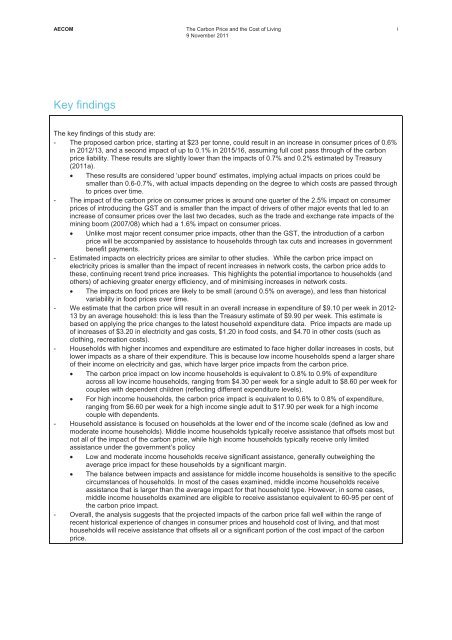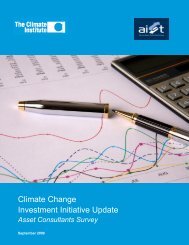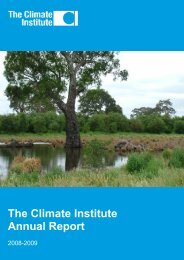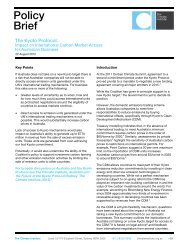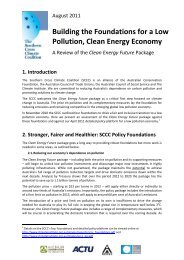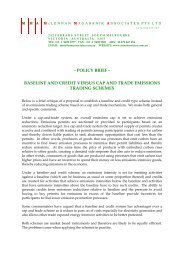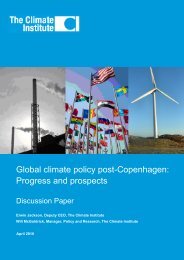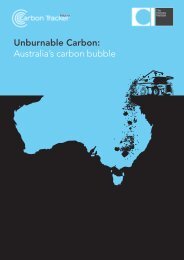The Carbon Price and the Cost of Living - The Climate Institute
The Carbon Price and the Cost of Living - The Climate Institute
The Carbon Price and the Cost of Living - The Climate Institute
Create successful ePaper yourself
Turn your PDF publications into a flip-book with our unique Google optimized e-Paper software.
AECOM<br />
<strong>The</strong> <strong>Carbon</strong> <strong>Price</strong> <strong>and</strong> <strong>the</strong> <strong>Cost</strong> <strong>of</strong> <strong>Living</strong><br />
9 November 2011<br />
i<br />
Key findings<br />
<strong>The</strong> key findings <strong>of</strong> this study are:<br />
- <strong>The</strong> proposed carbon price, starting at $23 per tonne, could result in an increase in consumer prices <strong>of</strong> 0.6%<br />
in 2012/13, <strong>and</strong> a second impact <strong>of</strong> up to 0.1% in 2015/16, assuming full cost pass through <strong>of</strong> <strong>the</strong> carbon<br />
price liability. <strong>The</strong>se results are slightly lower than <strong>the</strong> impacts <strong>of</strong> 0.7% <strong>and</strong> 0.2% estimated by Treasury<br />
(2011a).<br />
<strong>The</strong>se results are considered ‘upper bound’ estimates, implying actual impacts on prices could be<br />
smaller than 0.6-0.7%, with actual impacts depending on <strong>the</strong> degree to which costs are passed through<br />
to prices over time.<br />
- <strong>The</strong> impact <strong>of</strong> <strong>the</strong> carbon price on consumer prices is around one quarter <strong>of</strong> <strong>the</strong> 2.5% impact on consumer<br />
prices <strong>of</strong> introducing <strong>the</strong> GST <strong>and</strong> is smaller than <strong>the</strong> impact <strong>of</strong> drivers <strong>of</strong> o<strong>the</strong>r major events that led to an<br />
increase <strong>of</strong> consumer prices over <strong>the</strong> last two decades, such as <strong>the</strong> trade <strong>and</strong> exchange rate impacts <strong>of</strong> <strong>the</strong><br />
mining boom (2007/08) which had a 1.6% impact on consumer prices.<br />
Unlike most major recent consumer price impacts, o<strong>the</strong>r than <strong>the</strong> GST, <strong>the</strong> introduction <strong>of</strong> a carbon<br />
price will be accompanied by assistance to households through tax cuts <strong>and</strong> increases in government<br />
benefit payments.<br />
- Estimated impacts on electricity prices are similar to o<strong>the</strong>r studies. While <strong>the</strong> carbon price impact on<br />
electricity prices is smaller than <strong>the</strong> impact <strong>of</strong> recent increases in network costs, <strong>the</strong> carbon price adds to<br />
<strong>the</strong>se, continuing recent trend price increases. This highlights <strong>the</strong> potential importance to households (<strong>and</strong><br />
o<strong>the</strong>rs) <strong>of</strong> achieving greater energy efficiency, <strong>and</strong> <strong>of</strong> minimising increases in network costs.<br />
<strong>The</strong> impacts on food prices are likely to be small (around 0.5% on average), <strong>and</strong> less than historical<br />
variability in food prices over time.<br />
- We estimate that <strong>the</strong> carbon price will result in an overall increase in expenditure <strong>of</strong> $9.10 per week in 2012-<br />
13 by an average household: this is less than <strong>the</strong> Treasury estimate <strong>of</strong> $9.90 per week. This estimate is<br />
based on applying <strong>the</strong> price changes to <strong>the</strong> latest household expenditure data. <strong>Price</strong> impacts are made up<br />
<strong>of</strong> increases <strong>of</strong> $3.20 in electricity <strong>and</strong> gas costs, $1.20 in food costs, <strong>and</strong> $4.70 in o<strong>the</strong>r costs (such as<br />
clothing, recreation costs).<br />
- Households with higher incomes <strong>and</strong> expenditure are estimated to face higher dollar increases in costs, but<br />
lower impacts as a share <strong>of</strong> <strong>the</strong>ir expenditure. This is because low income households spend a larger share<br />
<strong>of</strong> <strong>the</strong>ir income on electricity <strong>and</strong> gas, which have larger price impacts from <strong>the</strong> carbon price.<br />
<strong>The</strong> carbon price impact on low income households is equivalent to 0.8% to 0.9% <strong>of</strong> expenditure<br />
across all low income households, ranging from $4.30 per week for a single adult to $8.60 per week for<br />
couples with dependent children (reflecting different expenditure levels).<br />
For high income households, <strong>the</strong> carbon price impact is equivalent to 0.6% to 0.8% <strong>of</strong> expenditure,<br />
ranging from $6.60 per week for a high income single adult to $17.90 per week for a high income<br />
couple with dependents.<br />
- Household assistance is focused on households at <strong>the</strong> lower end <strong>of</strong> <strong>the</strong> income scale (defined as low <strong>and</strong><br />
moderate income households). Middle income households typically receive assistance that <strong>of</strong>fsets most but<br />
not all <strong>of</strong> <strong>the</strong> impact <strong>of</strong> <strong>the</strong> carbon price, while high income households typically receive only limited<br />
assistance under <strong>the</strong> government’s policy<br />
Low <strong>and</strong> moderate income households receive significant assistance, generally outweighing <strong>the</strong><br />
average price impact for <strong>the</strong>se households by a significant margin.<br />
<strong>The</strong> balance between impacts <strong>and</strong> assistance for middle income households is sensitive to <strong>the</strong> specific<br />
circumstances <strong>of</strong> households. In most <strong>of</strong> <strong>the</strong> cases examined, middle income households receive<br />
assistance that is larger than <strong>the</strong> average impact for that household type. However, in some cases,<br />
middle income households examined are eligible to receive assistance equivalent to 60-95 per cent <strong>of</strong><br />
<strong>the</strong> carbon price impact.<br />
- Overall, <strong>the</strong> analysis suggests that <strong>the</strong> projected impacts <strong>of</strong> <strong>the</strong> carbon price fall well within <strong>the</strong> range <strong>of</strong><br />
recent historical experience <strong>of</strong> changes in consumer prices <strong>and</strong> household cost <strong>of</strong> living, <strong>and</strong> that most<br />
households will receive assistance that <strong>of</strong>fsets all or a significant portion <strong>of</strong> <strong>the</strong> cost impact <strong>of</strong> <strong>the</strong> carbon<br />
price.


